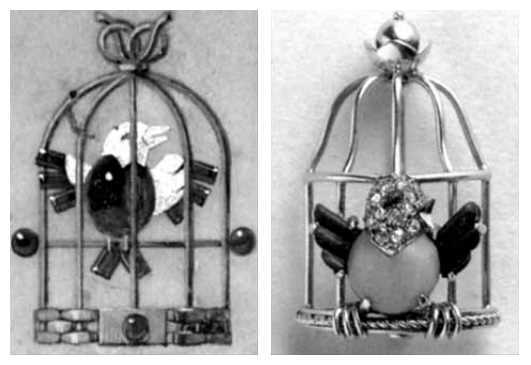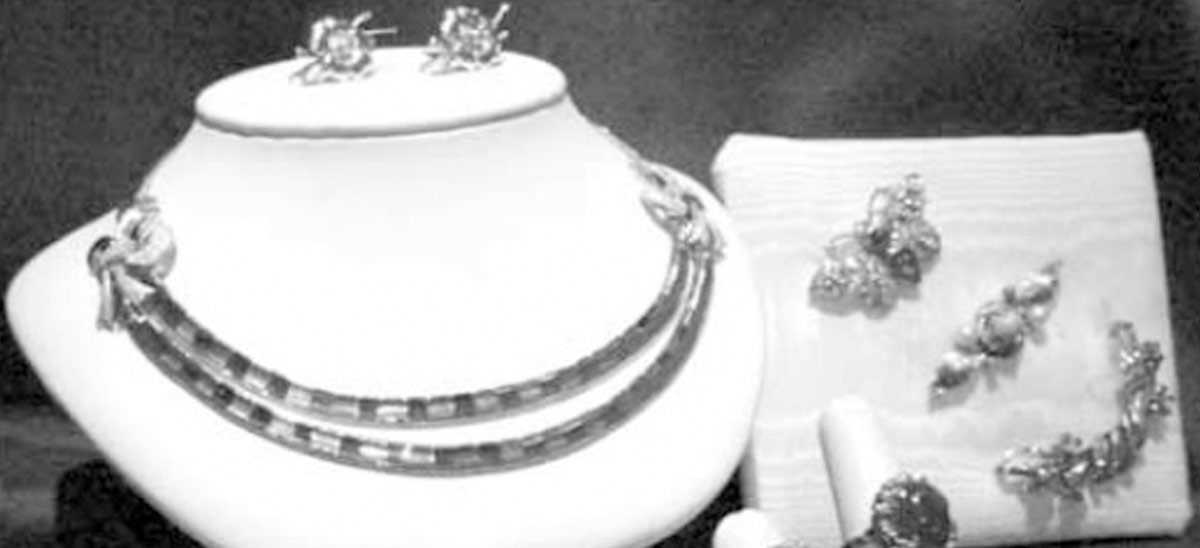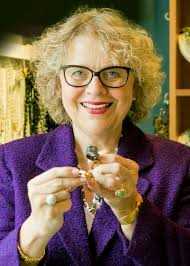
This time is not conducive to the manufacture of luxury goods. We reserve the platinum for the war effort, we ration the money, we even forbid at times the gold trade. We must reduce the use of metal: the jewel of the 1940s will be light or sometimes even hollow parts.
For lack of materials, jewels of the romantic and Victorian era are remodeled to the taste of the day or disassembled to recover stones, valuables easily transportable.
Indeed, during these war years, many people with jewelry know they will have to leave Europe. They sew gold coins, diamonds and other precious stones in the hem of their clothes, stuffed toys, etc. It is tragic circumstances besides that comes to us the idea that the jewels are an investment to counter the difficult times.
At the height of hostilities, the gemstone route between Europe and Southeast Asia is cut off. Colombia and Brazil are becoming suppliers of emeralds, aquamarines, tourmalines, amethysts, citrines and topaz, all of which combine to create surprising effects.
The retro style of the 1940s is often described as architectural and three-dimensional; we talk about jewelry “sculptures”. Although still influenced by Art Deco, its forms are softened by volutes with more modern curves. There are also abstract or more figurative compositions, such as knots, draperies, flowers or even insects and animals, like the panther or the snake. Mechanisms in motion, such as padlocks that open, fish scales that move, are also popular.
As soon as the United States goes to war, we fashion wristbands that look like tank tracks, planes and even flags that are soon decorated with the V of Victory!
Depending on its degree of alloy with copper or silver, gold takes the most unexpected colors: red, pink, green, white or gray. Jewelers thus play with the nuances of this precious metal or with the contrasts of polished and satin-finished surfaces. Add to this the diversity of textures: guilloche, twisted, faceted, chiselled, lace … On the jewel, we guess a fence, a wicker work, hexagons forming honeycombs, etc.
Cartier’s work depicting a bird in a cage (1942) evokes the occupation of France, then the bird at the door of the cage (1944) finally recalls the liberation (see photo). Other examples: the proud young rooster symbolizes resistance in France; gas hose clamps (also called snake chains) are reminiscent of the flexible connections of gas masks.

After the Second World War, a redistribution of wealth takes place, there is then a mixture of social classes. Men return home, we celebrate many marriages; it’s the beginning of a phenomenon called baby boom. A shadow on the table however: at the end of the decade, America learns that the Russians have the atomic bomb … It remains that life is generally more comfortable: TV, washing machine, refrigerator, etc.
The purpose of jewelry being to serve as an ornament, it is natural that they follow fashion. The garment is simpler and emphasizes the fine sizes. The skirts come back to mid-leg: 30 cm from the ground, dixit Christian Dior! The necks are decorated with brooches and the three quarters sleeves allow the wide bracelet. Hats, sleeves and other accessories are in demand. For their part, men complete their outfit with cufflinks and tie pins.
In this new world, France retains its prestige thanks to its sacred monsters, but from now on the competition is more present.
Indeed, in the wake of the economic boom that then lived in Italy, the actors of Italian design, both in clothing and jewelery, attract the attention of the world. We then witness the triumph of Made in Italy, characterized by fantasy and eclecticism. The greatest names in Italian jewelery are Bulgari from Rome, known for his use of coins as the main components of his jewelery.
In the post-war years, the rarity of stones and metal is still felt. Thin gold leaves are cleverly crafted to give the impression of sumptuous jewels. Fine stones, cheaper than rubies, sapphires or emeralds, are crimped. Topaz, citrine, amethyst and aquamarine as well as synthetic ruby and sapphire predominate to create an opulence effect (see photo).
The 1950s was inspired by naturalism: flowers, leaves, winged creatures (birds, butterflies, insects), frogs, snakes. We see motifs from the sea, like starfish, seahorses, fish and shells, but also ballerinas, clowns and scarecrows. The latch, a medallion of oval or heart shape, which opens on the photograph of a loved one is a pendant very widespread. As the scientific community is better known to the general public, certain forms of atomic structures appear in the design of the jewel. The creators of the time are also fond of abstract designs.
Famous artists will come to express themselves by the jewelery of art. We think of Alberto Giacometti, Alexander Calder (famous for his mobiles), Hans Arp, Max Ernst, Georges Braque, Jean Cocteau, Salvador Dali (the soft watch).
The 1950s offer heavier jewelry, platinum or gold, consisting of successive rows forming cascades. In fine jewelery, diamonds are still used and as early as 1948, the world’s largest diamond company, De Beers Diamond Corporation, launches the slogan “A diamond is eternal”. Ruby, sapphire and emerald then reappear on the market. Pink coral, turquoise, lapis lazuli, labradorite and enamel decorate necklaces, earrings, and famous cocktail rings. The typical pearl necklace of this time: 45 cm long, ranging from 7 mm in the center in gradient up to 3 mm near the clasp. The most affluent wear necklaces of two or three rows of pearls.
In England, the sale of the new jewel was strangled by a 100% tax. The estate jewelery market becomes very popular. Old and New Bond Street in London still remain today privileged places for the trade of this type of jewel.

Brooch Bird released, coral, lapis lazuli, diamonds and sapphire, mounted on platinum (Cartier). (Author’s Archives).
In America, French houses are good figure: Cartier, Van Cleef & amp; Arpels, Chaumet and Mauboussin become the jeweler of Hollywood stars, including Bette Davis, Joan Crawford, Grace Kelly (see photo) and Elizabeth Taylor.
The jewels of the 1950s are made to be worn during less formal events that make us forget the dark atmosphere of the post-war period. Rock and roll and Elvis Presley are at their peak, the record industry is very flourishing, the American women wear the loose shirt on tight pants and the girls feel beautiful in their crinoline underwear.
Fancy jewelery designers can fully express themselves with silver or gold metal, decorated with faceted glass imitating diamond (Rhine stones) or multicolored stones. Names like Coro, Sherman and Boucher have stood the test of time.
Several European designers exiled in the United States and Canada have influenced the development of jewelery in America. In the United States, Jean Schlumberger (jeweler at Tiffany), Harry Winston, diamond collector, and David Webb remain big names.
Originally from France, Gabriel Lucas opened a store in Sherbrooke Street in Montreal in 1940. He is now considered the father of fine jewelery in Quebec. Also from France, Georges Delrue is now recognized and we collect his jewelry on both sides of the Atlantic. Georges Schwartz has also made his mark. Switzerland’s Hermann Gutknecht led the workshops of Henry Birks and sons from where he designed the entire production, which was then shipped to other Canadian provinces. These jewelers generously distributed their know-how to apprentices who in turn stood out.

